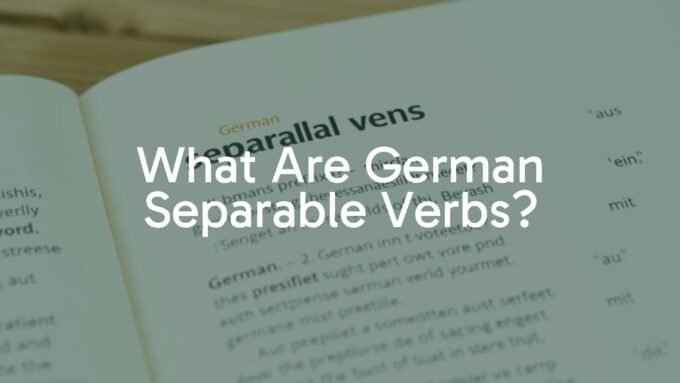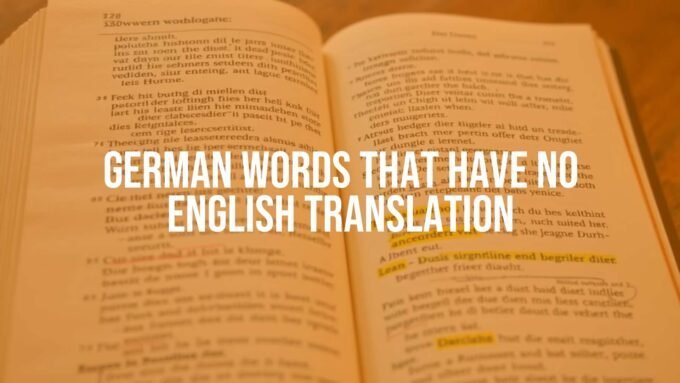German has three little words for “the”: der, die, das. Many learners find them tricky. In English, “the” works for everything. In German, the article depends on the noun’s gender. This can feel hard at first, but there are clear patterns you can learn to make it easier.
Getting these articles right matters a lot. Gender affects definite articles, indefinite articles, adjectives, and pronouns. If you skip learning der, die, das, building correct sentences becomes much harder. Let’s look at how German noun genders work and which article goes with each one.
What Are German Articles: der, die, das?
Der, die, das are definite articles, like “the” in English. The difference is that every German noun has a gender: masculine, feminine, or neuter. The article shows that gender.
Think of the article as part of the noun. Learn each noun with its article from the start. This habit makes later grammar steps simpler and faster.
What Is Grammatical Gender in German?
German sorts nouns into three genders: masculine, feminine, and neuter. This is a grammar label, not a real-world property. For example, “das Mädchen” (the girl) is neuter because of the ending, not because of the person it refers to. “Der Tisch” (the table) is masculine, and “die Tür” (the door) is feminine, with no link to their shape or use.
Some words for people and animals feel obvious (der Mann, die Frau), but that idea does not work for all nouns. The gender belongs to the word itself. Use a clear, rule-based approach, not guesswork.
When Do You Use der, die, das?
Use:
- der for masculine nouns
- die for feminine nouns
- das for neuter nouns
- die for all plurals
Examples: der Mann (the man), die Frau (the woman), das Kind (the child). Plural: die Männer, die Frauen, die Kinder. The plural form die is one nice rule that always stays the same.

How Do der, die, das Work with German Noun Genders?
Each article matches one gender. This also affects other words around the noun, like “a/an” and adjectives. You need to know both the noun and its article.
Memorizing helps, and so do patterns. Here are common rules for each gender.
Rules for Using der (Masculine)
Der marks a masculine noun. Examples: der Hund (dog), der Baum (tree). Common masculine groups:
- Male persons and animals: der Vater (father), der Hahn (rooster)
- Days, months, seasons: der Montag, der Januar, der Sommer
- Most weather words: der Regen (rain), der Schnee (snow)
- Compass directions: der Norden (north)
- Car makes: der Audi
- Most alcoholic and plant-based drinks (but das Bier)
Strong masculine endings:
- -ant, -ast, -ich, -ig, -ismus, -ling, -or, -us
Learning these groups and endings can greatly cut down your memorizing.
Rules for Using die (Feminine)
Die is for feminine singular nouns and for all plurals. Context shows if it’s singular or plural. Examples: die Frau (woman), die Katze (cat).
Common feminine groups:
- Female persons and animals: die Mutter (mother), die Henne (hen)
- Rivers in Germany, Austria, Switzerland
- Airplanes, motorcycles, ships: die Titanic
- Numbers used as nouns: die Eins (the one)
- Trees, fruits, flowers: die Eiche (oak), die Rose (rose)
Strong feminine endings:
- -a, -anz, -enz, -ei, -ie, -heit, -keit, -ik, -sion, -tion, -sis, -tät, -ung, -ur, -schaft
- Many words ending in -e: die Lampe (lamp), but der Junge (boy) is an exception
Rules for Using das (Neuter)
Das marks a neuter noun. Many learners find neuter less obvious. Common neuter groups:
- Young persons and baby animals: das Kind (child), das Baby (baby)
- Metals and chemical elements: das Aluminium
- Continents, cities, regions, most countries
- Units and measurements
- Letters and musical notes
- Hotels, cafés, restaurants, cinemas
- Other parts of speech used as nouns: gerunds and colors (das Schreiben, das Rot)
Strong neuter endings:
- -chen, -lein (diminutives), -icht, -il, -it, -ma, -ment, -nis, -o, -tel, -tum, -um
Diminutives (-chen, -lein) are very reliable: das Mädchen (girl), das Brötchen (roll).
What Are the Rules for Choosing der, die, das?
Over time, you will start to pick the right article without thinking. At first, learn patterns instead of only memorizing single words. Endings and meaning groups help you guess the gender of new nouns.
The main rules come from the noun’s ending and its group. Use these clues to make a good choice.
How Can You Identify the Gender of Any German Noun?
Spotting noun gender quickly is a very helpful skill. Don’t treat each word as random. Look for endings and meaning groups.
Try this:
- Check the ending (suffix). This is often the best clue.
- If the ending does not help, think about the meaning group (days, metals, trees, etc.).
Using both steps together will give you the right gender most of the time.
Recognizing Gender by Noun Endings
Suffixes are strong signals for gender.
- Feminine: -ung, -heit, -keit, -schaft, -tät, -ion, -ik
Examples: die Zeitung (newspaper), die Freiheit (freedom), die Universität (university), die Musik (music) - Neuter: -chen, -lein
Examples: das Mädchen (girl), das Fräulein (young lady) - Masculine: -ismus, -or, -ling, often -er from verbs
Examples: der Kapitalismus, der Motor, der Frühling, der Lehrer
These ending rules are usually more steady than meaning groups, so give them priority when you study.
Identifying Gender Through Noun Groups
Groups also help:
- Masculine: days, months, seasons (der Montag, der Juli, der Winter)
- Feminine: most trees, fruits, flowers (die Eiche, die Rose, die Banane)
- Neuter: colors as nouns (das Rot), verbs as nouns (das Essen), most elements
Learning words in groups saves time and helps you guess correctly with new words.
Other Common Patterns and Indicators
More helpful hints:
- Many English loanwords are neuter: das Internet, das Baby
- Diminutives (-chen, -lein) are almost always neuter
- Metals and most fractions are neuter: das Eisen (iron), das Gold (gold), das Drittel (a third)
There are exceptions, but these shortcuts reduce how much you must memorize.
How Do Cases Affect der, die, das?
German has four cases: nominative, accusative, dative, and genitive. Articles change form based on the noun’s job in the sentence (subject, direct object, indirect object, possession).
You need the case system to write clear, correct sentences. Articles are the main sign of case, so you must learn their changes.
Changing Articles According to Case
Articles change with case:
- Nominative (subject): der (masc), die (fem), das (neut), die (plural)
- Accusative (direct object): masculine der → den; feminine stays die; neuter stays das; plural stays die
- Dative (indirect object): masculine dem, feminine der, neuter dem, plural den
- Genitive (possession): masculine des, feminine der, neuter des, plural der
Masculine shows the biggest change between nominative and accusative (der → den).
Easy Reference: der die das Declension Chart
Here is a quick chart for the four cases:
| Case | Masculine (der) | Feminine (die) | Neuter (das) | Plural (die) |
|---|---|---|---|---|
| Nominative | der | die | das | die |
| Accusative | den | die | das | die |
| Dative | dem | der | dem | den |
| Genitive | des | der | des | der |
Review this chart often. Notice that feminine and neuter are the same in nominative and accusative, while masculine changes.
What Are Common Exceptions and Tricky Cases?
Rules and patterns help a lot, but German also has exceptions. These can slow you down, so learn them as you meet them. They often come from history or from loanwords.
Knowing these special cases helps you avoid common mistakes and gives you a clearer picture of how German works.
Words with Multiple Possible Articles
Some words change meaning with a different article:
- der Band (book volume), die Band (music group), das Band (ribbon/tape/bond)
- der Lama (Buddhist priest) vs. das Lama (the animal)
- der Kiwi (the bird) vs. die Kiwi (the fruit)
Regional use may also vary, for example with Joghurt (yogurt), which can be masculine, feminine, or neuter in different areas.
Exceptions to Article Rules
Some nouns break the common rules. Many words ending in -e are feminine (die Lampe), but der Junge (boy) is masculine. Diminutives (-chen, -lein) are almost always neuter, even for people: das Mädchen (girl).
Loanwords often become neuter, but not always. Because exceptions exist, learn new words with their article right away.
How to Remember der, die, das: Tips and Learning Strategies
Learning der, die, das takes time, but smart methods help a lot. Go beyond memorizing single words. Use patterns, practice often, and mix in creative memory tools.
Be patient, keep at it daily, and celebrate small wins as you go.
Grouping Nouns by Article
Always learn nouns with their article: der Tisch, not just Tisch. Use flashcards where the article stays attached to the noun. Sort your word lists by gender. Many learners also use colors (blue for masculine, red for feminine, green for neuter).
Study groups of words together: all days are masculine, most trees are feminine, etc. Grouping helps your brain store and find the right form faster.
Mnemonics and Practice Techniques
Use mnemonics. Make simple, funny images for hard words. For example, a king in blue for masculine (der), a queen in red for feminine (die), and a small cube in green for neuter (das). The more vivid the image, the easier it is to remember.

Practice a lot. Write short sentences, speak out loud, and do article drills. Describe things around you and always say the article. Use apps and quizzes that focus on articles. With steady practice, picking the right der, die, das will feel natural.













Leave a comment